This article has partner links that I may receive compensation from at no cost to you. Thank you for supporting my site by using them!
When I was a kid growing up in Tempe, Arizona, my family frequently went out to dinner at a place called The Spaghetti Company. Given my particularly picky palate, I preferred ordering the plainest pasta possible, spaghetti with butter & grated cheese.
But this grated cheese wasn’t the usual Parmesan or Romano found at most restaurants. The house special at The Spaghetti Company used a cheese I’d never heard of called Mizithra. Somehow, despite my general reluctance to try new foods, I ate it. I didn’t know what this mysterious cheese with a mythical-sounding name was or where it came from; all I knew was that it was delicious.
I now know that Mizithra is a soft Greek cheese made from sheep’s and/or goat’s milk. Its roots are from the island of Crete. The salted & aged Mizithra cheese used for grating over pasta is called Xynomizithra (“sour Mizithra”).
Although The Spaghetti Company was an Italian restaurant, its roots also ran across the Adriatic to Greece. It was a franchise of a restaurant chain you may have heard of called The Old Spaghetti Factory. The original Old Spaghetti Factory was founded by the Dussin family in Portland, Oregon, in 1969.
Guss Dussin was the child of Greek immigrants. The Arizona locations were operated by the Pulos family, who were relatives of the Dussins. In hindsight, I’d heard their last name but didn’t realize then that it was a Greek surname.
Book your hotel in Peloponnese now!In addition to serving classic Italian dishes, one item on the menu was a beloved family recipe from Guss Dussin’s Greek heritage: this Mizithra & butter pasta that I enjoyed so much.
When I visited Greece, these memories came flooding back as I encountered simple butter & Greek cheese pasta dishes at restaurants from Santorini & Naxos to the Peloponnese.
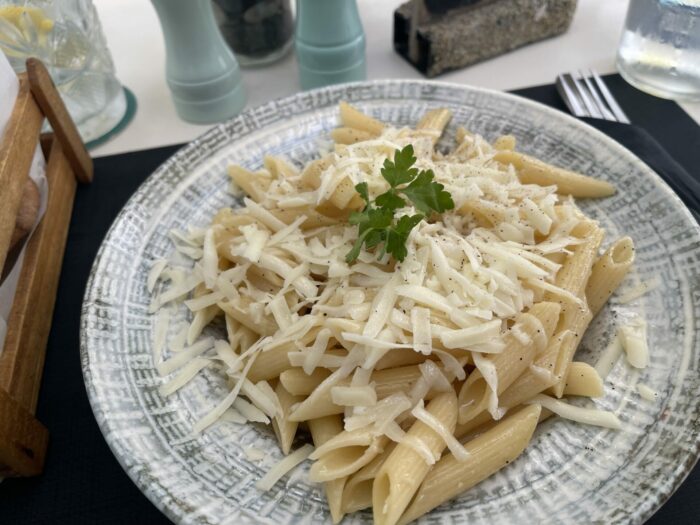
The History of Greek Pasta
Whenever most of us think of pasta, Italy, of course, is front of mind. However, I quickly learned that pasta can be found everywhere in Greece.
I originally thought the popularity of pasta in Greece stemmed from the period of Venetian rule over parts of the country. However, the opposite is true, & the history of Greek pasta goes back much further. Historians now believe pasta was first produced in ancient Greece before spreading to Italy. There are references to “laganon,” a combination of flour and water that was cooked flat & then cut into strips, dating back to around 1,000 BC. Eventually, this led to the lasagna we know and love today.
Before that, some variation of flour & water was also found elsewhere across the Middle East, Asia, and Africa. Pasta (or a related variant) is one food item that truly connects nearly every culture. Even if that connection also spurs many arguments about who created it first.
Nowadays, there are plenty of local pasta types and dishes across Greece, such as hilopites (small pasta squares), skioufichta (a boat-shaped pasta from Crete), and pastitsio (a dish similar to lasagna, but made with tubes of pasta), to name a few.
Eating Greek Pasta in the Peloponnese
When I toured Arcadia in the Peloponnese, I encountered pasta at nearly every meal.
At the outstanding Villa Incognito in Tripoli, we had two pasta dishes as part of a tasting menu.
First, we had maniatiki, a homemade pasta stuffed with traditional smoked cured pork called sygklino & served with Tripoli’s gruyere sauce. It paired perfectly with my favorite Greek wine, Hoof & Lur, from Troupis Winery.
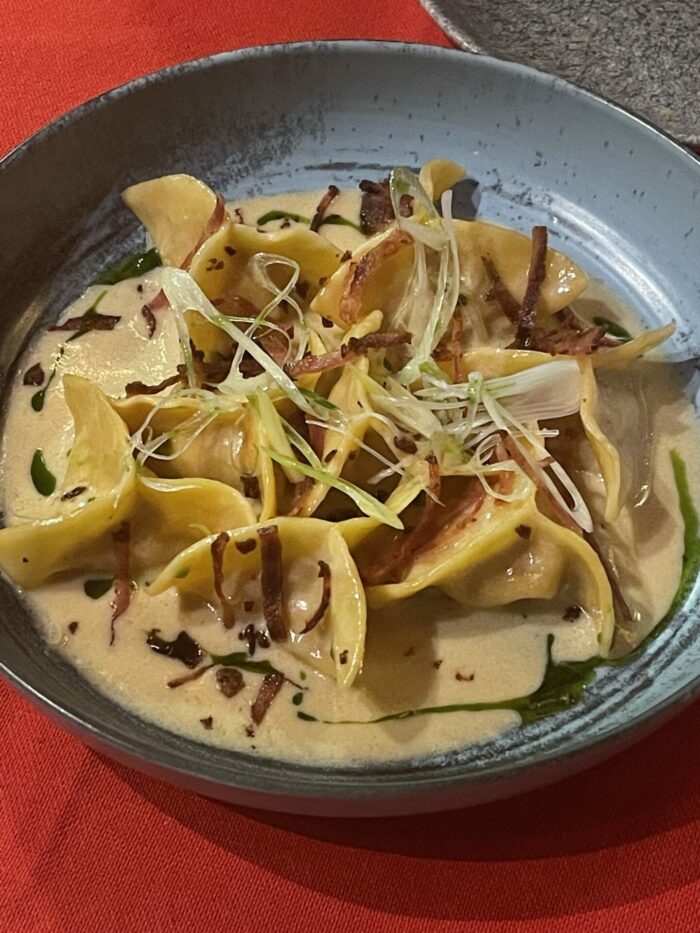
Later, we had crispy rooster cooked in Agiorgitiko red wine with sweet spices and tomato served over a bed of homemade hilopites and a mousse made from Manouromizithra goat cheese.

Hilopites (also spelled as chilopites or hylopites) are small square-shaped pasta. This type of pasta was the one I ate the most in the Peloponnese.
In the mountain town of Ano Doliana, we had dinner at a restaurant called Tholos. One of the dishes was chicken served over hilopites.

The next day, we visited a local restaurant & hotel called Xenonas in the small town of Platanos. We enjoyed an excellent feast, including hilopites in tomato sauce served with Mizithra.

One of the best meals I had in Arcadia was eaten on the side of the road, courtesy of Fungi Hellas. Following a truffle hunting demonstration featuring a cute dog named Luna, we gorged on barley pasta with mushrooms and truffles, bread with olive oil, and raki while sitting near a waterfall.

Making Greek Pasta in Agios Petros, Arcadia
After all of this Greek pasta eating, we still had one more stop where we could get to see the pasta-making process in action.
The picturesque town of Agios Petros is small, but despite its size of just about 500 residents, it’s more lively than other villages we saw amongst the lush green mountains of the area. In addition to the centerpiece Apostles Peter and Paul Holy Orthodox Church, several restaurants and shops make it a nice place to stop.
We headed to Malevos Greek Pasta on one of the few side streets of Agios Petros for a pasta-making workshop. Owner Dimitris has been making pasta for over 20 years. It’s a family affair, as his wife runs the village food shop, where the pasta and other local delicacies are sold.
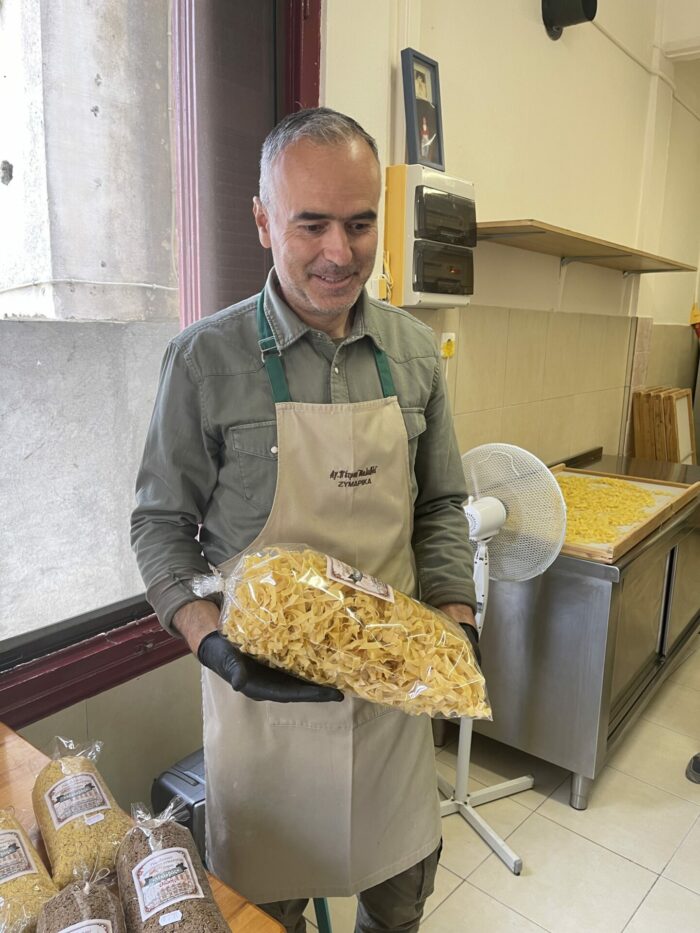
Using flour produced just outside of Tripoli, along with eggs (about 5 per kg of flour), milk, and salt, Dimitris produces a few styles of pasta, including hilopites. They even make custom orders for locals, who can bring their own fresh eggs and milk to use in the pasta.
We watched as Dimitris made a batch of pasta. It’s a fairly simple process. The dough is put through a machine after the ingredients are blended in the mixer.
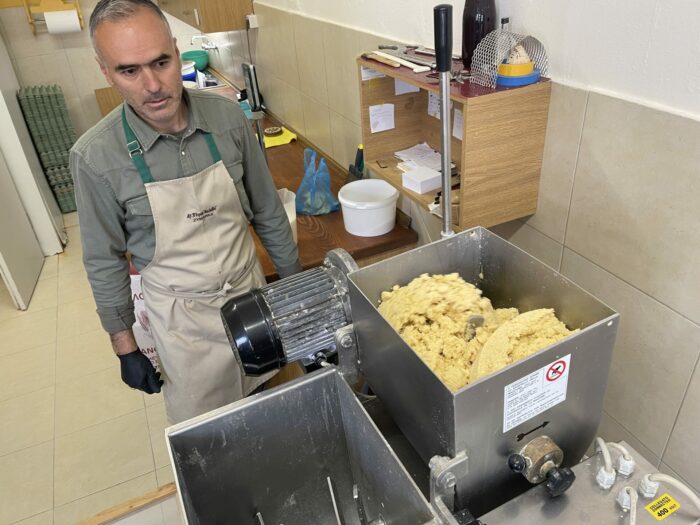
As the dough passes through the attachment that creates its shape, a timed blade circles to cut the pasta into the proper size.
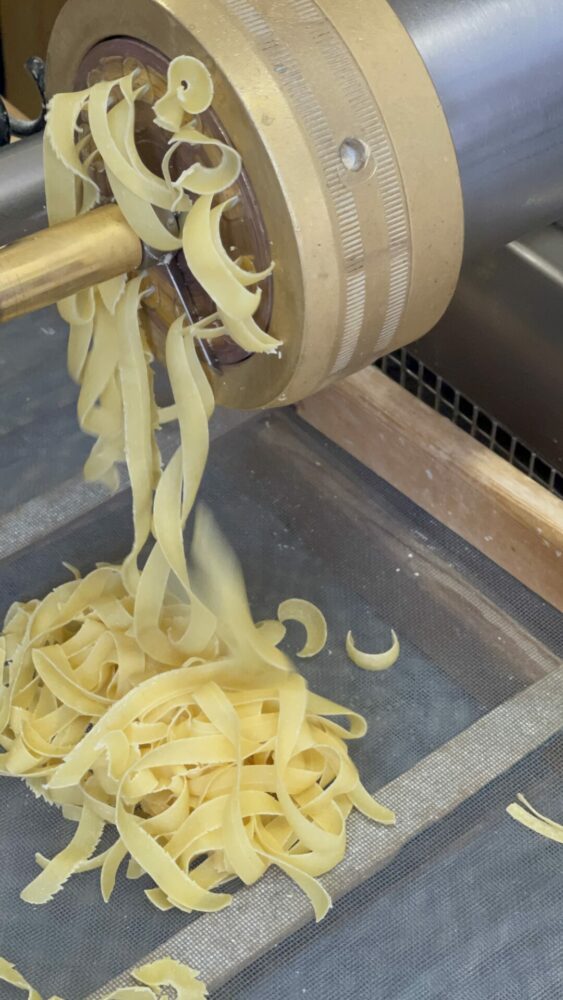
This fresh pasta is then placed onto drying racks for 20 hours.
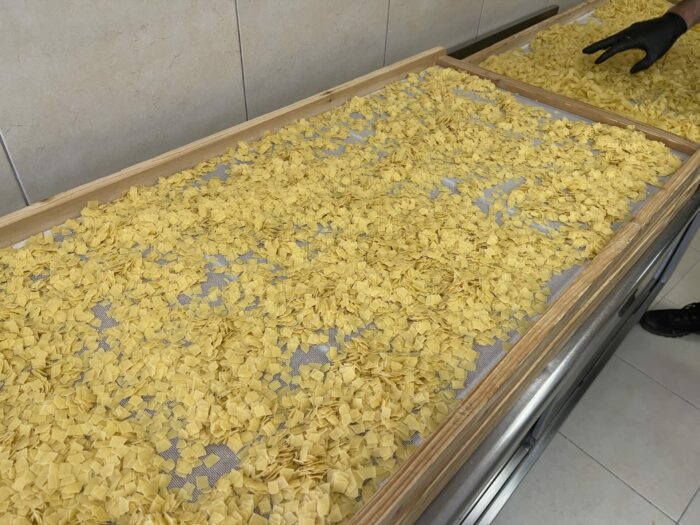
After the pasta-making demonstration, it was time to head to the Malevos shop just across the street from the church. Their wares, including shelves filled with pasta, were proudly on display.
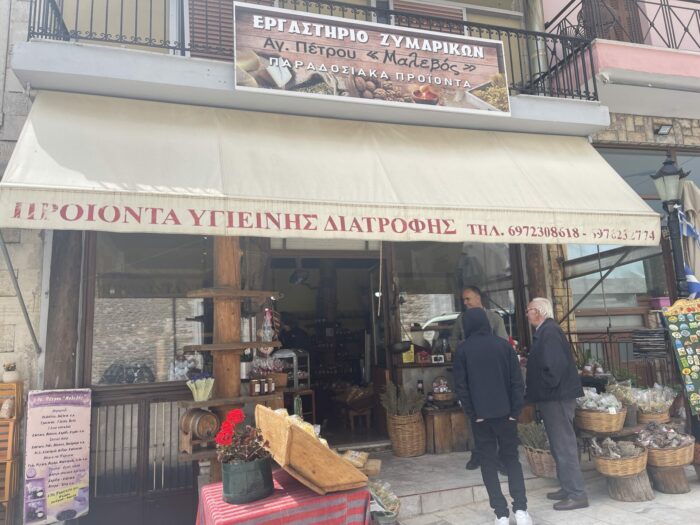
Maria, Dimitris’ wife, welcomed us with open arms, offering us samples of various local products, including produce & cherry cordial. She also gave each of us a gift: a bag of their hilopites to take back home as a taste of Greece.
When I eat that pasta, I will have it with some butter and Mizithra cheese. My palate may have become more adventurous since I was a kid, but I will always love the classics. This simple dish will not just transport me back to Greece but also to my childhood in Arizona.
Watch a video of my visit to Arcadia here:
Here are some great Arcadia tours & activities.
If you’re looking for a place to stay in Arcadia, check out these hotels. I stayed at the Palatino Rooms & Apartments & enjoyed my stay.
Note: My visits to these restaurants & shops in Arcadia, Greece, were part of a TBEX press trip. All opinions are 100% my own.

